Saint Germain is at present an Ascended Master, the Hierarch of the New Age. In his last incarnation as the Count de Saint Germain in the XVIII century he exerted a great influence on the course of world history
The most mysterious man of the XVIII century
The majority of his biographers and researchers agree in their views that Saint Germain had the most direct relation to the House of Ragoczy, the Royal House of Hungary.
The contemporaries of Saint Germain describe him as a man of medium height and proportionate build, having regular features. His look captivated everyone who looked into his eyes.
This is the way the Countess d’Adhémar describes Saint Germain and his appearance at the Court of France: “It was in 1743; the rumor spread that a stranger, enormously rich judging by the magnificence of his jewelry, had just arrived at Versailles. Whence did he come? That is what no one has ever been able to learn. His bearing, and intellect, struck one from the first minute of conversing with him. He had a pliant, graceful figure, delicate hands, a small foot... His smile showed the most beautiful teeth in the world, a pretty dimple adorned his chin, his hair was black, his eyes were soft and penetrating. Oh! What eyes! I have nowhere seen their equal. He appeared about forty to forty-five years old.” (1)
Another contemporary described Saint Germain with the following words: “Saint Germain is of medium height and elegant manners; his features are regular; his hair black; his face energetic and full of genius; his posture is noble, innate only to the great. The Count dresses simply but with taste. His only luxury is demonstrated by a large number of diamonds, covering his outfit. He wears them on every finger, and they are set in his snuffboxes and his watches. One evening he appeared at court with shoe buckles covered in diamonds, which Herr v. Gontaut, an expert on precious stones, estimated at 200,000 Francs.” (2)
The Count de Saint Germain was considered the most mysterious man of the XVIII century. This mystique was manifested in everything. His life – full of secrets, his uncertain age – fueling rumors; his direct acquaintance and communication with practically all the monarchs and numerous political figures of Europe and Asia; his participation in a number of major political affairs of that time; his diplomatic activities and a multitude of talents; his abilities, scientific researches and technical inventions, alchemy experiments, healing and clairvoyance, the gift of soothsaying…
The dates of his birth and death were shrouded in mystery. It seemed, the Count grew no older. Isabel Cooper-Oakley in her book, “The Comte de Saint Germain. The Secret of Kings”, written in 1911, brings about testimonies of the people that had seen the Count. These evidences range from 1710 to 1822 (please, note that in 1710 this mysterious man already looked like a 45-year-old). Here is the earliest record:
“The old Countess v. Georgy who fifty years earlier had accompanied her husband to Venice … approached the Count:
“Will you have the kindness to tell me,” said the Countess, “whether your father was in Venice about the year 1710?”
“No, Madame,” replied the Count quite unconcerned,” my father passed away long before that time; but I myself was living in Venice at the end of the last century and the beginning of this century; I had the honor to pay you court then, and you were kind enough to admire a few Barcarolles of my composing which we used to sing together.
“Forgive me, but that is impossible; the Comte de St. Germain I knew in those days was at least 45 years old, and you are approximately that age now.”
“Madame,” replied the Count smiling,” I am very old.”
“But then you must be nearly 100 years old.”
“That is not impossible.”
The above-mentioned Countess d’Adhémar records in her diary the date she met Saint Germain for the first time: “… on the eve of the murder of the Duke de Berri [1820]”. And he looked precisely like he did at their first meeting.
The knowledge of the Count extended over everything in the world
Saint Germain spoke many languages. He did it so perfectly that he was taken for a native of the country where he spoke the language. The number of these languages included French, English, German, Italian, Spanish, Portuguese, Russian, Sanskrit, Greek, Chinese, Arabic and others.
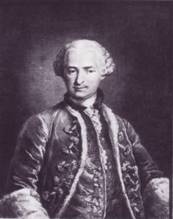 He knew history so well that it seemed he had participated in the events about which he spoke. He knew history so well that it seemed he had participated in the events about which he spoke.
The Count was a virtuoso musician and could masterfully play the violin and the piano without notes. The musical compositions he played were not only romances but the most complicated concerti as well.
The Count was also a fine oil-painter. The paints he invented radiated extraordinary brilliancy. The dresses of the people he painted seemed to glow like gems.
Saint Germain was skilled in healing and in the application of the medicinal herbs. Some of his contemporaries considered that the remedies he invented, along with the habit of consuming simple food, built up the health of the Count and prolonged his life.
At the Court of the Shah of Persia, where the Count was staying from 1737 to 1742, he was engaged in scientific research and demonstrated his aptitude in precipitating and increasing the brilliance of the gemstones, particularly diamonds.
The Count made a great deal of discoveries in various fields of science and technology.
According to the witness of Graf Karl Cobenzl, Saint Germain was developing the mass production techniques. For instance, his technique of bleaching the flax made the fabric look like Italian silk, and his preparation of skins done with the utmost perfection surpassed the best morocco leather in the world. Saint Germain invented the dyeing of silks and woolens, carried to a perfection hitherto unknown; the dyeing of woods in the most brilliant colors, applying the method of deep penetration with the commonest ingredients and, therefore, at a very moderate price.
Many of the inventions presented by Saint Germain have long become the common property of the human civilization. However, some of them are still beyond our imagination. For instance, Graf Maximilian Joseph von Lamberg in 1775 wrote that he had seen a spinning-wheel invented by Saint Germain that produced two yarns simultaneously, but this mechanism required the division of attention and simultaneous control of these processes by the worker.
Graf von Lamberg regretfully noted that people at that time were not able to use this mechanism because of their state of consciousness and abilities. This example speaks eloquently about the fact that then, at the dawn of the technological revolution, Saint Germain endeavored to set the pace on the path of development of the inner abilities of a human.
Louis XV valued Saint Germain’s mastery of alchemy so highly that he assigned the Count a laboratory and a suite of rooms at the royal Château de Chambord. According to the witness of the contemporaries, the alchemy sessions of the Count were nothing but miracles.
The geography of Saint Germain’s travels covers Europe, Asia and Africa. Besides that, he was keenly interested in America. Madame de Pompadour wrote that Saint Germain had traveled all around the world, and the King graciously listened to his stories on his travels over Asia and Africa and about the Courts of Russia, Turkey and Austria.
Political affairs
One of the most complicated aspects of his biography deals with politics. At one time he is at the Court of the Shah of Persia, exerting a beneficial influence on the small-minded and suspicious ruler; at another time he serves France, then he helps England, then he renders assistance to Prussia, then he is in intimate contact with the representatives of the Austrian Court, then he assists in organizing a coup d’état in Russia, etc. His actions are ruled by a clear understanding of historical processes and a keen political vision and prevision. He is always in the thick of things, in the focus of the world history, and always busy with restoring the lost equilibrium.
Thus, King Louis XV entrusts Saint Germain with a mission to establish peace between France and England in order to save the first from a catastrophe.
In the Russian coup d’état of 1762 Saint Germain takes part as well, though there are only indirect proofs of his participation in that event. However, the pattern of the coup d’état speaks for itself. A.N. Barsukov in “The Stories from the Russian History of the XVIII century” says that the fundamental coup d’état was performed without internecine bloodshed. All events of that day and night (June 28, 1762), upon reflection, look like the actions of a skillful surgeon, operating quickly and accurately. Among the participants of the coup d’état that stand out are the Orloff Brothers, Gregor and Alexis, who were in contact with Saint Germain and enthroned Catherine II.
From the memoirs of the Countess d’Adhémar we get to know the way Saint Germain endeavored to save France from an impendent catastrophe and the royal family from death. Saint Germain warned Louis XVI and Marie Antoinette about the imminent revolution, yet all these efforts were in vain.
As Elizabeth Clare Prophet says in her book, “it was an instructing and painful lesson: even a man of the most profound wisdom, having the noblest intentions and the knowledge of how to solve the world problems, on which the rise and the downfall of the nation depend, had to obey the free will of the mortals. He could give advice but not orders, and if his advice was neglected, the only thing left for him to do was to leave.”
The Great Initiate
Saint Germain was a Great Initiate and, therefore, the philosophical and the mystical side of his life was even more mysterious and complicated for research, investigation and comprehension.
Saint Germain wrote a classical occult work called “The Most Holy Trinosophia”, where he used a combination of contemporary languages with the hieroglyphics of ancient times and a number of poems of profound philosophical contents.
Saint Germain was the founder of secret societies, the leader of the Rosicrucians, Freemasons, the Knights Templars of those times. The thorough study of the mason’s archives, according to Isabel Cooper-Oakley, reveals that Saint Germain was one of the élite representatives of the French masons who were present at the Great Congress in Paris in 1785.
His invisible influence penetrated many spiritual societies that appeared far and wide. And he applied his efforts in order to integrate those independent societies into the whole. It is worth mentioning that those spiritual societies were (secretly or evidently) based on the same fundamental principles, as carried out by the true messengers of the Great White Brotherhood, such as the evolution of human nature, reincarnation, cause-and-effect relation, purity of life and the Divine Omnipresent power.
In her letters, Helena Roerich called the Count of Saint Germain, “Member of the Himalayan Community”, the Stronghold of Knowledge and Light. Helena P. Blavatsky noted in The Theosophical Glossary, “Count St. Germain was certainly the greatest Oriental Adept Europe has seen during the last centuries”8.
At the end of the 18th century Saint Germain promised the Countess d’Adhémar that he would return again in 100 years. And indeed, at the end of the 19th century Saint Germain appeared in order to assist Master M. (El Morya), Master K.H. (Kuthumi) and Helena P. Blavatsky in the foundation of the Theosophical Society.
In the 1930’s, already in his ascended state, Saint Germain had a contact with Guy and Edna Ballard. In 1958 He started his cooperation with Mark L. Prophet through the organization “The Summit Lighthouse” with the purpose of publishing the teachings of the Ascended Masters on the matters of practical spirituality. Through Mark and Elizabeth Clare Prophet Saint Germain provided many prayers and meditations for solving the problems of the current period of time. The Decree of the Violet Flame was one of the most important and well known among them.
Nowadays, Saint Germain continues giving His Messages together with the other Masters through the Messenger of the Great White Brotherhood, Tatyana N. Mickushina.
Today, Master Saint Germain comes in the forefront as the patron of the Age of Aquarius.
He played many roles in his previous lives, and here are some of Saint Germain’s incarnations
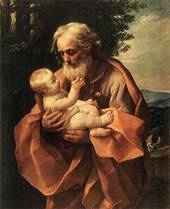 Joseph, the husband of Mary, the mother of Jesus. Joseph, the husband of Mary, the mother of Jesus.
Joseph, according to the Gospel, though a direct ancestor of King David, was a poor man and lived in a small town of Nazareth, working as a carpenter. Very little information on Joseph is given in the gospels, except the facts concerning the birth of Jesus.
The Virgin Mary was promised to Joseph. Then according to Matthew (1:19-24) Joseph, the husband of Mary, was visited by Archangel Gabriel in his dream and found out that she conceived before their marriage and so “he had in mind to secretly divorce her.” However, Gabriel comforted Joseph, saying “do not be afraid to take Mary home as your wife, because what is conceived in her is from the Holy Spirit. She will give birth to a son, and you are to give him the name Jesus, because he will save his people from their sins.” After that the evangelist stated that Joseph “took Mary home as his wife. But he did not consummate their marriage…”
The Holy Writ tells in detail the story about the angel of God who warned Joseph in his dream about Herod’s intention to kill Jesus. Joseph listened to the Angel’s warning and took his family to Egypt. They returned after Herod’s death.
According to his life history, Joseph died at the age of 100 years soon after his visit to Jerusalem with 12-year old Jesus Christ. There is no further mention of Joseph. Although there is an apocryphal gospel “History of Joseph the Carpenter”.
In the catholic tradition Saint Joseph is venerated as the patron of the Universal Church.
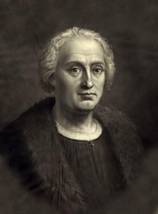 Christopher Columbus (1451-1506) – Christopher Columbus was a navigator, an explorer who reached the Americas. He was born in Genoa, Italy, and spent one third of his life in the voyages. Christopher Columbus (1451-1506) – Christopher Columbus was a navigator, an explorer who reached the Americas. He was born in Genoa, Italy, and spent one third of his life in the voyages.
According to his contemporaries’ descriptions Christopher Columbus was taller than the average, of good stature and appearance and strongly limbed. His reddish hair became grey early in his youth, making him looking older for his age. His face long and chapped exposed lively eyes and an aquiline nose. Columbus showed both strong faith in the Divine foresight and prophecies and rare practicality. He had a quick wit, a strong ability to convince and versatile knowledge. He had married twice and had two sons. Columbus believed that he was exactly the one whom God had chosen to be the messenger of “a new heaven and a new earth” that was mentioned in Revelation by Saint John and foretold by Isaiah even earlier. Studying the Bible prophecies, he would often quote the biblical texts related to his mission which resulted in his production of the “Book of Prophecies” (in Spanish “El Libro de las Profecías”). Even the British encyclopedia stated that Columbus discovered the Americas more due to the help of the prophecies than the astronomy.
Columbus made four voyages in his life. The first voyage (1492-93) with 90 men aboard the 3 ships, “Santa Maria”, “Pinta”, and “Niña”, left from Palos, Spain, on the 3rd of August 1492, crossed the Atlantic ocean, discovered the Sargasso Sea, reached an island in the Bahamas and named it San Salvador where they landed on October 12th 1492 (which is the official holiday in honor of Christopher Columbus' arrival in the Americas).
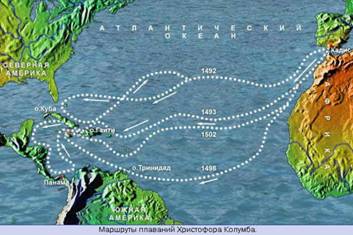
During his following voyages Columbus discovered many islands of the Caribbean Sea and explored the shores of Central America. His discoveries resulted in the colonization of the lands and the foundation of the Spanish settlements, as well as in the cruel enslavement and mass extermination of the aboriginal people called “Indians” by the troops of conquistadors
Columbus was not the first explorer to reach the Americas. The islands and the shore of North America had been visited by Norsemen for hundreds of years before him. However, Columbus’ discoveries were of universal and historical importance. The fact that he had found the new part of the world was finally proven by the voyage of Magellan.
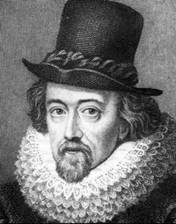 Francis Bacon (1561-1626) – Francis Bacon was an English philosopher, statesman, essayist and an outstanding author of the Renaissance. Bacon, named the greatest mind of the western civilization, is known as the founder of the inductive methodologies for scientific inquiry or scientific methods which marked a new turn in the process of scientific cognition of the world. Francis Bacon (1561-1626) – Francis Bacon was an English philosopher, statesman, essayist and an outstanding author of the Renaissance. Bacon, named the greatest mind of the western civilization, is known as the founder of the inductive methodologies for scientific inquiry or scientific methods which marked a new turn in the process of scientific cognition of the world.
On the whole, Bacon considered science the greatest advantage, which was almost self-evident, and expressed it in his famous aphorism "Knowledge is power" (lat. Scientia – potentia est.)
Science was not popular in those times and was criticized a lot. Having analyzed the attacks, Bacon came to a conclusion that God had not forbidden the exploration of nature. On the contrary, He gave man his mind that had the desire to cognize the universe. People should only understand that there are two ways of acquiring knowledge: 1) getting the knowledge of good and evil and 2) the cognition of things and processes created by God.
According to Bacon, it was forbidden for people to acquire the knowledge of good and evil, as God gives people this knowledge through the Bible. At the same time, man must study created things with the help of his mind. Therefore, science must take its decent place in the empire of man. The role of science is to multiply people’s power and to provide wealthy and worthy life.
Bacon believed that the purpose of education was to acquire the right method of getting knowledge in order to be able to orientate yourself in the outer world. He considered the following methods as the right ones: observation, exploration, experiment and the development of the ability to come to concrete conclusions, taking into account general facts (deductive method). He was sure that mastering was the result of understanding and experience.
In the meanwhile, a group of intellectuals with the elite of literary men of the Elizabethan era gathered around him. Some of them were the members of a secret society who named themselves “The Knights of the Helmet”.
The objective of “The Knights” was to make education more perfect by means of spreading English language and creating new literature which was not written in Latin but in a language that any Englishman could understand. Bacon was the initiator for the translation of the Bible into English (King James Bible), as he believed that reading of the Holy Writ must be accessible for common people.
In 1890s in the original edition of William Shakespeare’s plays and in Francis Bacon’s works as well as in the works of other authors of the Elizabethan era, some peculiar cipher texts were found. Those texts revealed that Bacon had written the plays attributed to William Shakespeare and that he actually was the son of Queen Elizabeth and Lord Leicester.
Bacon caught a cold during one of his scientific experiments and died. Already being seriously ill, he informed one of his friends, lord Arundel, that the experiment was a success. The eminent scholar believed that science would give man power over nature which will result in the life improvement
* * *
H.P. Blavatsky wrote in “The Secret Doctrine” that at the end of every century the Teachers make an attempt to assist spiritual progress of Humankind. And at the end of any century you inevitably feel the presence of a powerful wave of ever-increasing spirituality. One or several of the Teachers appear in the world as the conductors of this spirituality, leaving for humanity some part of the occult knowledge or Teaching. This is especially true when describing this outstanding person and Teacher – Saint Germain.
|